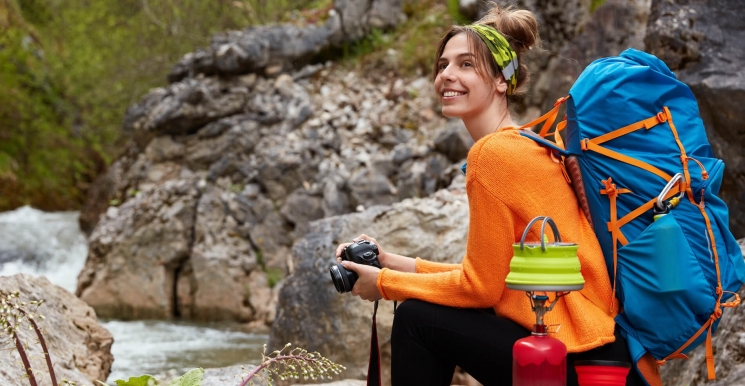- +9779851087405 24/7 Phone Support
- query@adventurehighpass.comEmail Support
Staying Safe While Trekking in Nepal: Tips and Guidelines

April 02, 2023, Post by: Adventure Highpass
You're in for a special experience if you want to trek in Nepal. It is a trekker's paradise because of the breathtaking scenery, majestic mountains, and vibrant culture. Trekking in Nepal, however, may be difficult and dangerous, particularly for people who are unfamiliar with the terrain and temperature. It's crucial to go by a few recommendations and rules to keep yourself secure. We'll talk about staying safe when trekking in Nepal in this article.
Understanding the Terrain
Understanding the terrain is the first step to staying safe while trekking in Nepal. The paths in Nepal can be difficult, rough, and steep, and the country is home to some of the highest peaks in the world. Be ready for long walks, challenging hills, and slick descents. To understand what you're getting into, it's crucial to do some research on the trekking route and terrain before you go.
Planning Your Trek
You must correctly plan your trek before you begin. This includes selecting the hiking route, the appropriate time of year, and hiring a qualified guide. September through November and March through May are the ideal months for trekking in Nepal. The views are breathtaking, and the weather is dry and consistent during these months.
Choosing the Right Equipment
While trekking in Nepal, the appropriate gear can significantly impact your safety. The right trekking footwear, warm clothing, rain gear, a first aid kit, and a backpack are all essential. Make sure your gear is of high quality and appropriate for the environment.
Staying Hydrated and Nourished
Trekking in Nepal can be physically taxing, so it's important to eat well and remain hydrated to stay safe. Water purifying equipment should be carried, and you should drink lots of water. To maintain a high level of energy, it's crucial to eat nutritious foods.
Altitude Sickness
For travelers in Nepal, altitude sickness is a regular issue, particularly when traveling to higher altitudes. Headache, nausea, and lightheadedness are some of the signs of altitude sickness. It's crucial to properly acclimatize and ascend gently to prevent altitude sickness. When you see any signs, head down right away and get help.
Respect the Culture
During trekking, it's crucial to respect Nepal's rich cultural heritage. This include dressing modestly, respecting local traditions, and avoiding harming wildlife.
Communication
When trekking in Nepal, communication is key. Carry a whistle, a GPS, and a fully charged cell phone. Inform your loved ones of your plans and keep them informed of your development.
Travel Insurance
When trekking in Nepal, travel insurance is essential. Make sure to purchase travel insurance that includes traveling at altitude and trekking coverage.
Trekking Permits
A trekking permit is required to go on a trek in Nepal. Ensure you have the necessary permits and keep them on you at all times.
Environmental Considerations
If not done carefully, trekking in Nepal may have a harmful effect on the environment. It's crucial to use eco-friendly items, carry your trash with you, and steer clear of single-use plastics.
Emergency Evacuation Plan
When trekking in Nepal, having an emergency evacuation plan is essential. Be sure to be familiar with the closest medical facilities' locations and emergency evacuation protocols.
Hiring a Licensed Guide
When trekking in Nepal, it is highly advised to use a certified guide. A certified guide can assure your safety, assist you with terrain navigation, and offer insightful explanations of the customs and culture of the area.
Weather Conditions
Nepal's weather can be erratic and subject to sudden changes. It's critical to stay up to date on weather prediction and be ready for all circumstances. Trekking might be difficult from June to August during the monsoon season because of the severe rain and landslides.
Group Trekking
Trekking with a group might be more fun and safe than trekking by yourself. You can help each other out, divide up the work, and have someone to turn to in an emergency.
Final Say
While trekking in Nepal can be a life-altering experience, putting safety first is crucial. Some of the most important advice for remaining safe while hiking in Nepal includes knowing the terrain, planning your walk, selecting the appropriate gear, staying hydrated and fed, respecting the culture, and being ready for emergencies. By adhering to these recommendations, you may enjoy a memorable and secure trekking trip in Nepal, a stunning Himalayan nation.
FAQs
Is a visa required to trek in Nepal?
Yeah, even for hiking, you need a visa to enter Nepal. A visa can be obtained at the airport upon arrival, or you can apply for one at the Nepalese embassy in your nation.
How much does trekking in Nepal cost?
The price of a trek in Nepal is influenced by the trek's length, route, and additional services. A trek in Nepal might cost anything from $500 to $2000 on average.
Is high altitude sickness a concern there?
Certainly, trekking in Nepal can be dangerous due to altitude sickness, especially at higher altitudes. To prevent altitude sickness, it's crucial to acclimatize correctly and rise gradually.
What time of year is best suited for trekking in Nepal?
September through November and March through May are the ideal months for trekking in Nepal. The views are breathtaking, and the weather is dry and consistent during these months.
Related Blog(s)
- Annapurna Circuit Trek Permit: An Ultimate Guide for Trekking Enthusiasts
- Everest Base Camp Trek Difficulty, Route & Preparation
- Manaslu Circuit Trek: A Hidden Trekking Gem in Nepal
- Top 7 Reasons to Visit the Everest Region of Nepal
- Everest Base Camp Trek vs Annapurna Base Camp Trek: Which One to Choose?
- Best 3 Nepal Treks: A Guide to Top Trails
- Capturing the Beauty of Annapurna Region: A Photographer's Paradise
- A Beginner's Guide to Trekking in Nepal: What You Need to Know

